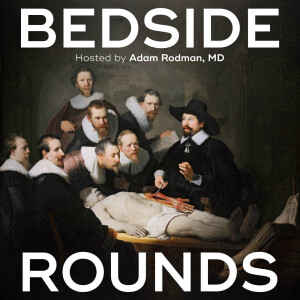
A darkened laboratory with an eerie green glow; a photograph of the bones of a woman’s hand published on the front pages of newspapers throughout the globe; mysterious rays that promise to change medicine forever but also cause horrific disease in their champions and pioneers. In this episode, called Bone Portraits, I tell the story of two men -- Wilhelm Roentgen, the discoverer of x-rays who would later win a Nobel Prize, and Clarence Dally, the first victim of x-ray radiation. Listen to the thrilling conclusion of our to part series on the dawn of diagnostic imaging! We’ve got all this, plus a double-header #AdamAnswers, in Episode 23 of Bedside Rounds, a tiny podcast about fascinating stories in clinical medicine. Sources: Mahroo, et al. 'Dilatation' and 'dilation': trends in use on both sides of the Atlantic. Br J Ophthalmol. 2014 Jun;98(6):845-6. doi: 10.1136/bjophthalmol-2014-304986. Epub 2014 Feb 25. King, Gilbert. “Clarence Dally — The Man Who Gave Thomas Edison X-Ray Vision.” Smithsonian.com, March 14, 2012. Goodman, et al. Medical Writing: A Prescription for Clarity. P37. Gagliardi, Raymond A. “Clarence Dally: An American Pioneer,” American Journal of Roentgenology, November, 1991, vol. 157, no. 5, p. 922 Dunlop, Orrin. Deleterious effects of X-rays on the human body. Electrical Review 1896;29:95 Cheng, Tsung. Dilation vs. Dilatation. American Journal of Cardiology. February 15, 1994. Volume 73, Issue 5, Page 421 Brown, Percy. American martyrs to radiology. Clarence Madison Dally (1865-1904). 1936. Obrien, Frederick. In Memoriam: Percy Brown, MD. Radiology. December 1950Volume 55, Issue 6 Sansare K, et al. Early victims of X-rays: a tribute and current perception. Dentomaxillofac Radiol. 2011 Feb;40(2):123-5.
view more
More Episodes
25 - Salt Water
 2017-08-01
2017-08-01
 2
2
 2017-08-01
2017-08-01
 2
2
24 - W56.22xA (The Making of A Disease)
 2017-06-22
2017-06-22
 2017-06-22
2017-06-22
22 - The Assassination
 2017-04-24
2017-04-24
 7
7
 2017-04-24
2017-04-24
 7
7
21 - Renegades
 2017-03-25
2017-03-25
 2017-03-25
2017-03-25
20 - Buried Alive
 2017-02-21
2017-02-21
 2017-02-21
2017-02-21
19 - Of Madness and Moons
 2017-01-19
2017-01-19
 3
3
 2017-01-19
2017-01-19
 3
3
18 - Dr. Livingstone, I presume?
 2016-12-30
2016-12-30
 2016-12-30
2016-12-30
17 - The Iceman
 2016-11-25
2016-11-25
 2016-11-25
2016-11-25
16 - Phineas
 2016-10-26
2016-10-26
 2016-10-26
2016-10-26
15 - Innumeracy
 2016-09-04
2016-09-04
 2016-09-04
2016-09-04
14 - The First Trial
 2016-01-23
2016-01-23
 2016-01-23
2016-01-23
13 - The Oath
 2015-06-30
2015-06-30
 2
2
 2015-06-30
2015-06-30
 2
2
12 - P.I.M.P.
 2015-03-31
2015-03-31
 2015-03-31
2015-03-31
11 - Frank's Sign Redux
 2015-03-12
2015-03-12
 2015-03-12
2015-03-12
10 - Car Talk
 2015-01-28
2015-01-28
 2015-01-28
2015-01-28
9 - Laennec's Cylinder
 2015-01-18
2015-01-18
 2015-01-18
2015-01-18
8 - I will harm
 2014-12-29
2014-12-29
 2014-12-29
2014-12-29
7 - The Medicine of the Empire Strikes Back
 2014-09-26
2014-09-26
 2014-09-26
2014-09-26
01245678910111213141516171819
Create your
podcast in
minutes
- Full-featured podcast site
- Unlimited storage and bandwidth
- Comprehensive podcast stats
- Distribute to Apple Podcasts, Spotify, and more
- Make money with your podcast
It is Free
- Privacy Policy
- Cookie Policy
- Terms of Use
- Consent Preferences
- Copyright © 2015-2024 Podbean.com






